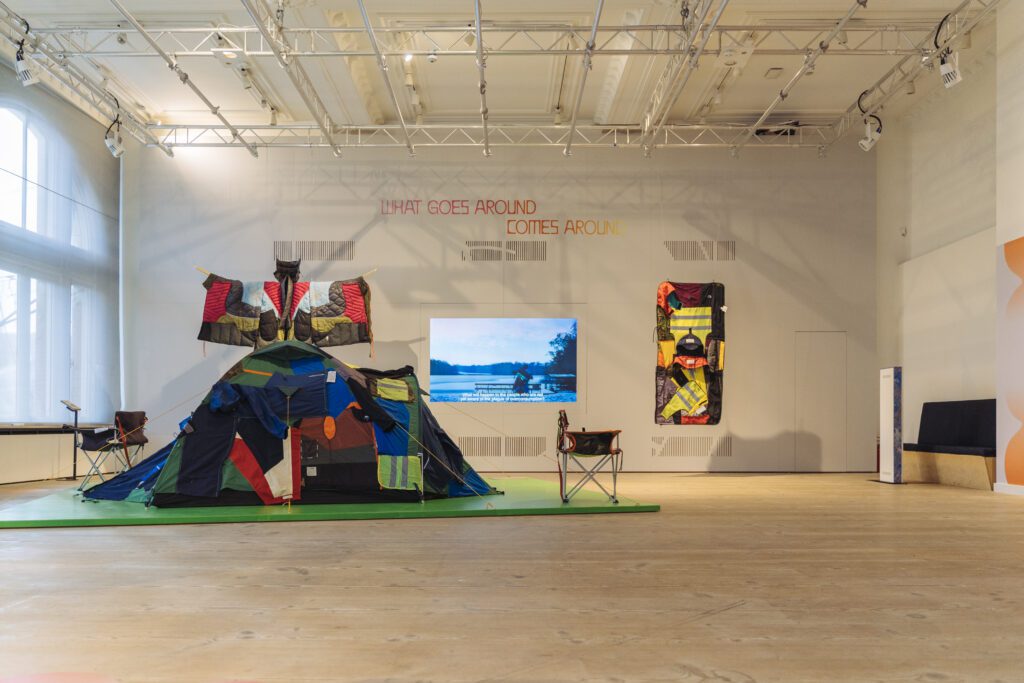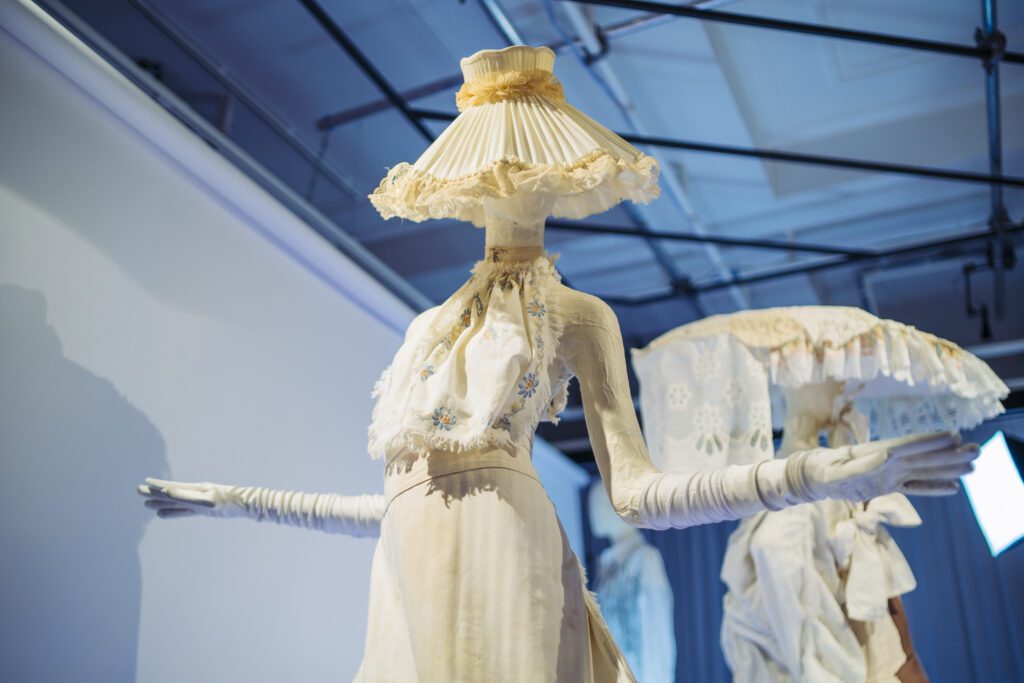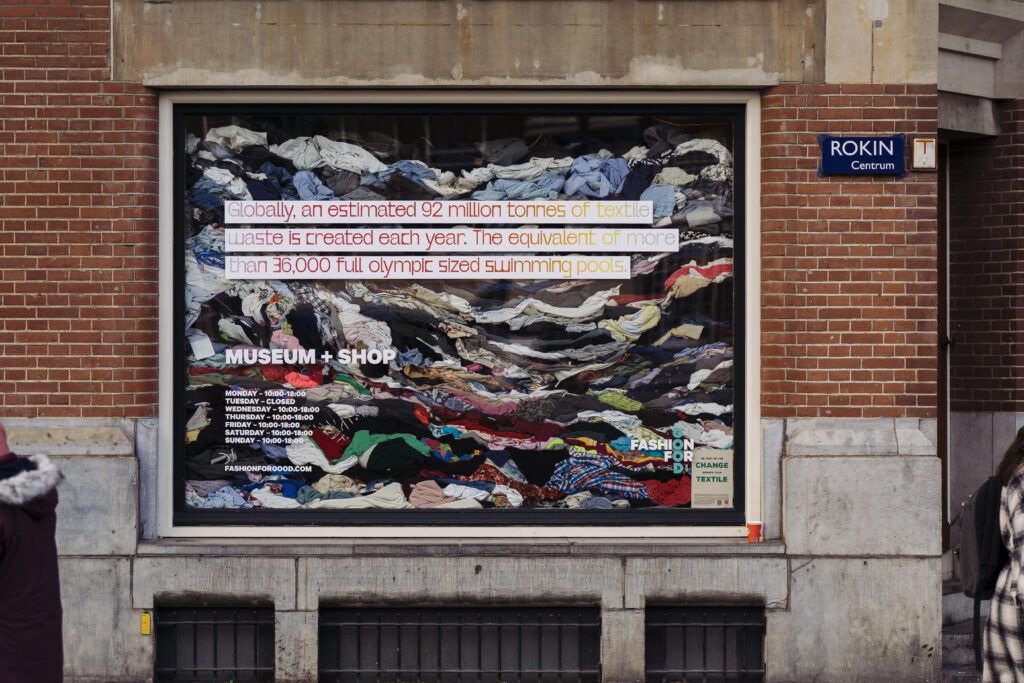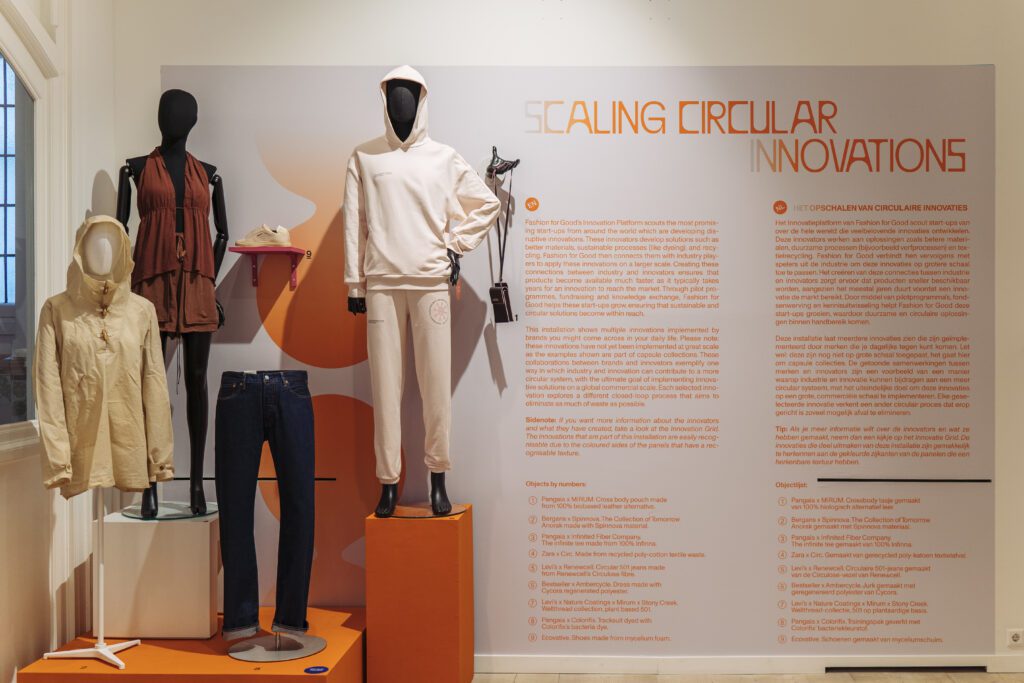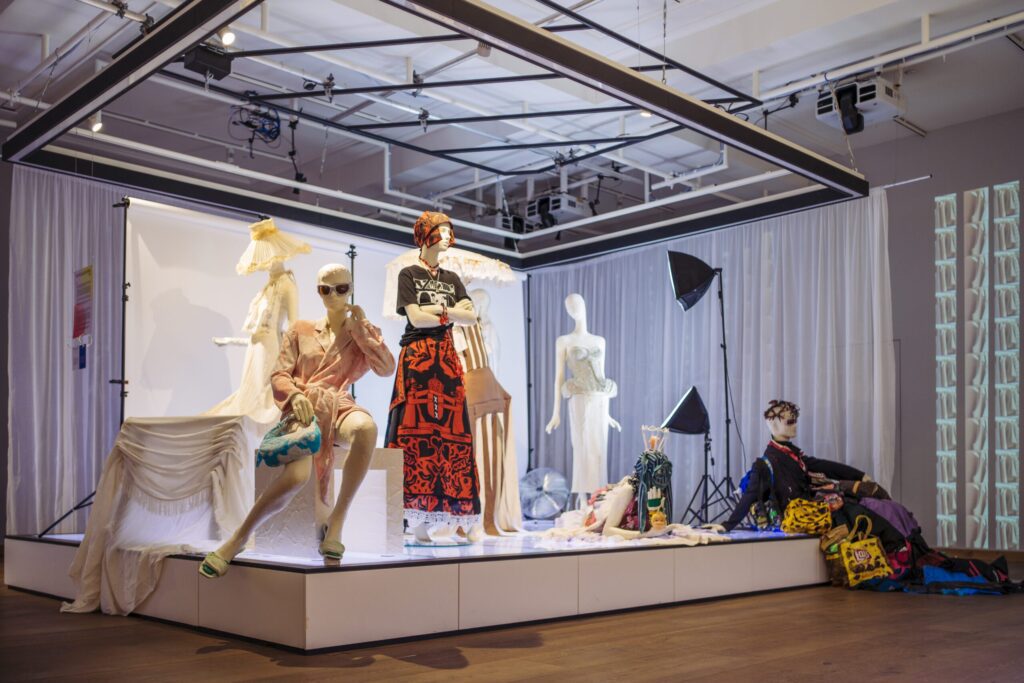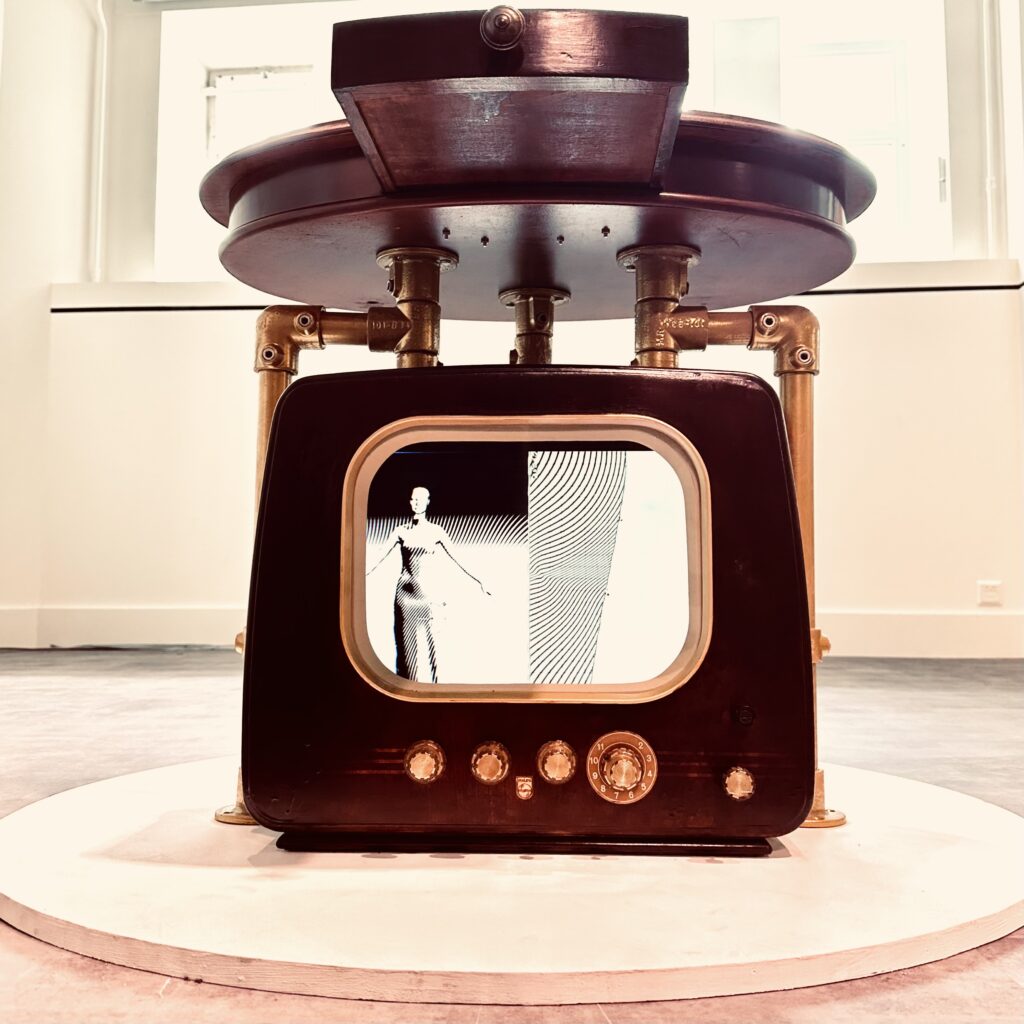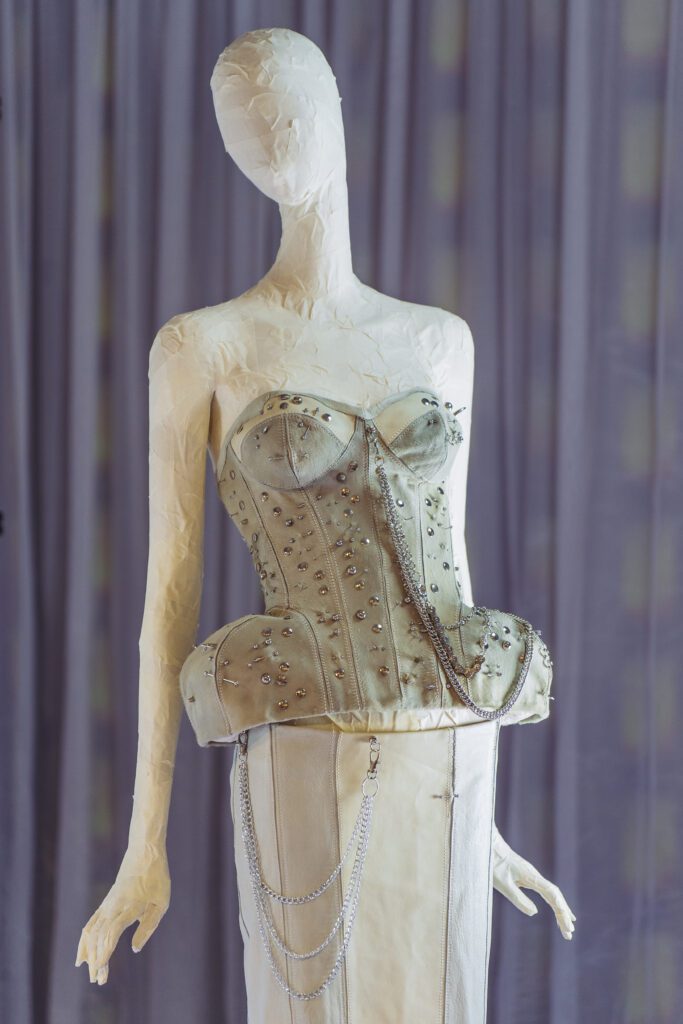What Goes Around Comes Around (2024)
The Fashion for Good Museum developed the exhibition “What Goes Around Comes Around” on the basis of a care structure, with the intent to help visitors understand their power in the climate crisis. The exhibition explored circular practices in fashion and the shift from sustainability to circularity.
What Goes Around Comes Around (27 January – 5 June 2024)
The starting point of the exhibition What Goes Around Comes Around was the critical conversation around the term ‘sustainability’ and a noticeable language shift to the term ‘circularity’ within the fashion industry. Circularity is a current political topic, with various countries pledging to ambitious circularity goals in the next decades, and recent legislation being ratified at national and European levels of government. This is particularly relevant in Amsterdam, as the municipality is progressively working up to become a circular city by 2050, with intermediate goals for 2025 and 2030.
It is becoming increasingly clear that the term ‘sustainability’ is losing its power and credibility. It is generally considered too vague, broad and easily misused, which works to the benefit of businesses looking to ‘greenwash’ or misrepresent their practices for marketing reasons. This is partly due to the fact that there is no universally agreed definition or metric for sustainability. As a result of this development, the term ‘circularity’ and the idea of a ‘circular economy’ are becoming more popular in industries and systems thinking. To the wider public circularity remains a vague concept, however. People are generally unsure how to interpret circularity, even when it might already be embedded in their daily lives. What Goes Around Comes Around was therefore created as a tangible, visual, inspirational experience of what circularity means and how it can be applied.
Designing for circularity means to design without creating waste or pollution, as all materials are continually reused instead of discarded. A circular system is restorative and regenerative, and it addresses the systemic issues of overproduction, textile waste and waste colonialism. It is important to acknowledge that circularity is not a new idea, but one that has been embedded in Indigenous knowledge and ways of life going back millenia. While there are many inspiring examples of innovative thinking and research pushing the fashion industry forward, the exhibition also explored everyday practices and traditions to empower visitors to take collective action. Through the exhibition, the museum was used as a community space where people could engage in and learn about sustainable consumption, discover inspiring examples of applied innovation, circular and socially engaged fashion by a mix of Dutch and international creatives.

Care structure
Considering widespread eco-anxiety, caused by the accelerating effects of climate change and a growing sense of helplessness in the face of the structural issues at its cause, the Fashion for Good Museum increasingly focussed on visitor experiences and fostering positive emotions. The exhibition was therefore constructed on the base of a care structure, drawing on contemporary mental health practices. Inspired by Steven R. Covey’s framework of the Circles of Influence, introduced in his 1989 book The 7 Habits of Highly Effective People, the care structure was designed to guide visitors’ emotional journeys and leave them with active hope. Introducing visitors to the concept of their ‘circle of influence’, the exhibition presented the various dimensions of the fashion industry. From smallest to largest, the three dimensions (individual, community, industry) represent different levels of impact and responsibility. By helping visitors become aware of their own power and by providing concrete tools for action, community-building, education and inspiration, the exhibition was intended to help visitors navigate the current world of fashion.
Exhibition design
The graphic language of the exhibition, created by Sara Biatchinyi, was joyful and playful through a use of bright colours. It was inspired by ideas around connecting dots, patterns that become a pathway or a puzzle piece, gradients showing how one dimension of the fashion industry fades into another. The care structure manifested as a colour code throughout the exhibition, with pink referring to the individual dimension, yellow to the community dimension and orange to the industry dimension. The text panels, walls and display elements were designed to form a pathway indicating how these three circles overlap and progress, from a focus on individual- and community practices, to a focus on industry practices, and finally circling back to individual actions at the end of the exhibition.

Content of the exhibition
The exhibition brought together an international mix of young designers, established (couture) designers, showcasing new installations, loan objects and commercial implementations, illustrating circular practices at different levels of the fashion industry. The installations merged various media, including fashion, film, art, science and new technologies to introduce a conversation on sustainability and circularity as well as highlighting the key issues of overproduction and textile waste. The interdisciplinary and multisensory qualities of the exhibition thereby created accessible entry points for visitors to learn about the complex topic of circularity.
The exhibition opened with the ‘Oven Mitt Coat’ by designer Nicole McLaughlin, which illustrated overconsumption and consumerism in a humoristic way, and gently probed visitors to consider their own consumption habits. The exhibition highlighted community practices with an installation by Dutch collective The Patchwork Family, illustrating the way in which individual designers are strengthened when they come together in a non-competitive environment. The short documentary ‘TEXTILE MOUNTAIN’, filmed by Fellipe Lopes in Kenya, Belgium and Ireland, discussed textile waste dumping and waste colonialism in the Global South. Through this documentary, the exhibition particularly sought to open up conversations around textile waste and overproduction, suggesting the need for degrowth to achieve a circular fashion industry. To empower visitors to engage in these conversations, a small library provided books to read on the various themes of the exhibition, and offered suggestions for a range of resources, from podcasts to digital platforms, where visitors can begin their learning journey.
Diving into emerging industry practices, a mixed-reality installation created by Cypherloom explored circularity within AR and digital design. The exhibition also showcased recent examples of implemented innovations and sustainable leather alternatives in the fashion supply chain, as well as addressing circular policies such as Extended Producer Responsibility which could come to shape the fashion industry in the coming years. Finally, the exhibition showcased examples of circular practice in high fashion, with new work by Atelier Reservé. The Amsterdam-based design duo created the installation ‘NECESSARY’ for this exhibition, presenting end-of-use solutions and a possible vision of the future where durable and high-performance materials are key to human survival. An installation of loaned couture showcased diverging examples of circular practices from designers Ronald van der Kemp, Marga Weimans, BOTTER and Yuima Nakazato. As a final stopping point of the exhibition, an interactive installation with a table and seating invited visitors to sit and process what they learned. The intent of this reflective installation was to visualise a better future and to leave suggestions for achieving that future on a noticeboard, leaving visitors with active hope and visualising the possibilities of collective action.
Conversations for Good
Terminology in the sustainable fashion world can be confusing. We sat down with the artists and designers featured in this exhibition to reflect on sustainability, circularity, the current state of the fashion industry and more. Listen to the interviews here!
Other Education Programmes

Museum Legacy
On this page you find our Museum legacy document, celebrating the incredible journey of the Fashion for Good Museum. As the Museum doors have closed on June 5th, 2024, we want to extend our deepest gratitude to you, our amazing community of conscious consumers and visitors.
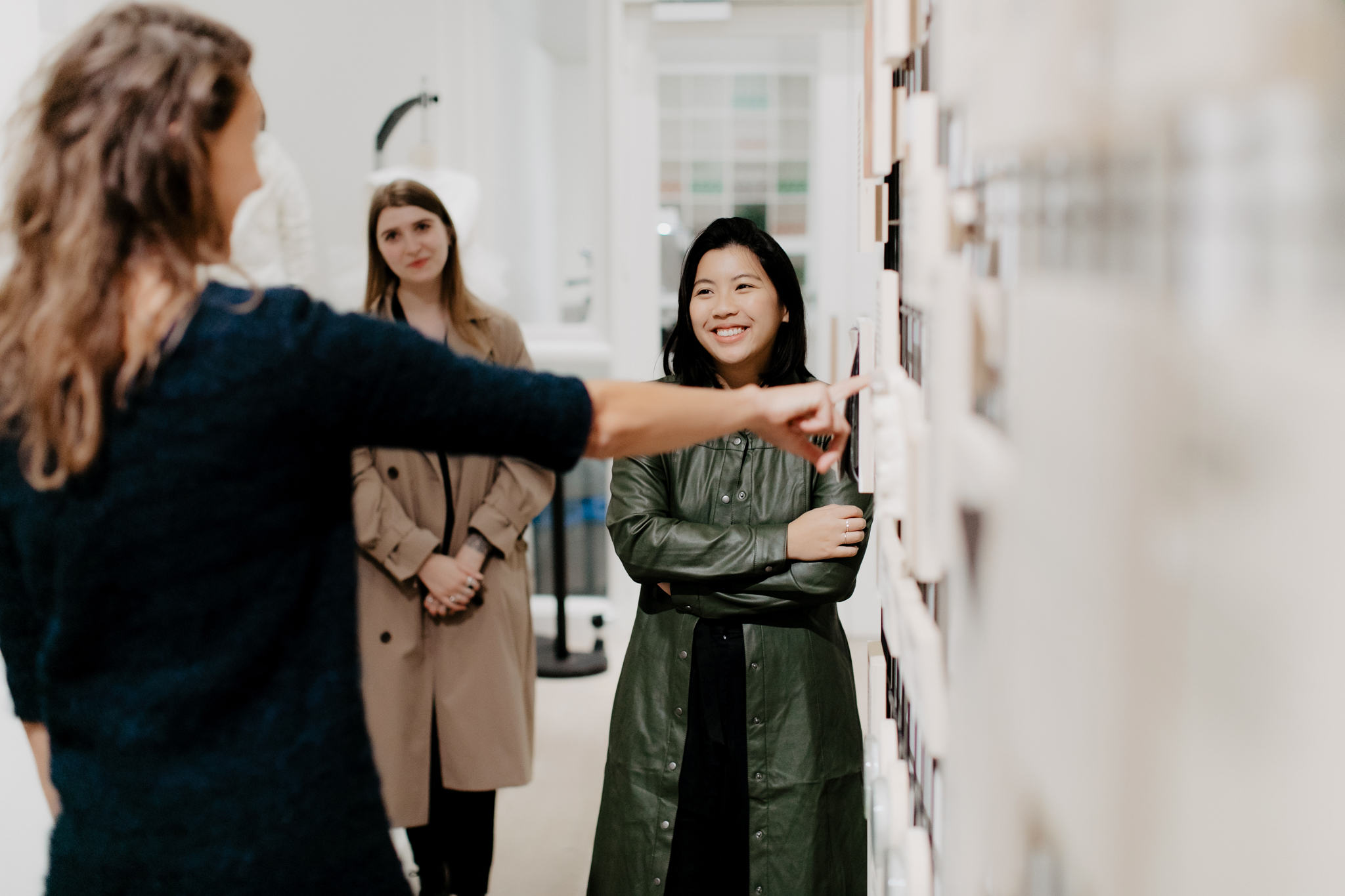
Educational Resources
Change starts with the new generation of industry professionals, but also with the individual consumer. Our educational programmes and tools help younger generations understand their role in the narrative, giving them the knowledge and tools to take action and change fashion for the better.

Past Exhibitions
Discover some of our past exhibitions on this page. Read up on our approaches to sustainable exhibition development and discover the artists and designers we featured in our exhibitions GROW, Knowing Cotton Otherwise and What Goes Around Comes Around.
